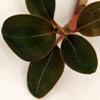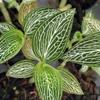Culture of Ludisia
The Common Jewel Orchids
Jewel Orchid Cultural Information by Michael Dorris No one seems to know what Ludisia means or where it came from. In 1826 John Lindley made the genus Haemaria, meaning blood red, in "Genera andSspecies of Orchidaceous Plants". Then in 1970, P. Hunt called this plant Ludisia in the Kew Bulletin and the confusion continues. Ludisia is used more in the U.S.A then elsewhere so the confusion might be confined. Generally regarded as having 22 chromosomes and being a containing a single species. Growing from India to Indonesia and south to South East Asia. Grows up to 10 in (25 cm) tall, up to 3 in (7.5 cm) long leaves and a terminal 4 to 12 in (10 to 30 cm) tall inflorescence with asymmetrical flowers that last a few weeks.
Cultivation. Found in evergreen, lowland forests in the shade. In humid habitats with rocky substrates along streams and rivers, terrestrial to lithophytic. It is adapted to the dry winter (40F, 5C) and the hot wet spring, summer and fall (90F, 34C). Ludisia is one of the warmest growing jewel orchids. The winter months are from November to February, when the plant blooms. Seed capsules mature in 3 to 4 weeks, opening to let the seeds drift away before the spring rains. Ludisias can dry to the point of leaf wilt then loss, which will not kill them and root in a glass of water. The Chinese make a tea from the leaves of Ludisia for lung and liver diseases. This might be the biggest jewel orchid. Described as a highly variable species, there are a few forms on the market. Slow growing.
 Ludisia discolor
was first described by John Ker-Gawler in 1818 as Goodyera discolor; A. Richard in 1825 called it Ludisia discolor in the Dictionnaire Classique d' Histoire.
Ddiscolor mea1ns differently colored or two colors.
Ludisia (Haemaria) discolor var. dawsoniana is the name of the most common form of this jewel orchid.
It is reportedly from Thailand.
This form has velvety burgundy leaves with 3 orange veins, sometimes red veins and white flowers.
Can turn into large clumps if allowed.
Does very well outside in zone 9 and 10 in the U.S.A. Above 40F (5C).
Slugs and snails do eat them. Very easy to grow.
Ludisia discolor
was first described by John Ker-Gawler in 1818 as Goodyera discolor; A. Richard in 1825 called it Ludisia discolor in the Dictionnaire Classique d' Histoire.
Ddiscolor mea1ns differently colored or two colors.
Ludisia (Haemaria) discolor var. dawsoniana is the name of the most common form of this jewel orchid.
It is reportedly from Thailand.
This form has velvety burgundy leaves with 3 orange veins, sometimes red veins and white flowers.
Can turn into large clumps if allowed.
Does very well outside in zone 9 and 10 in the U.S.A. Above 40F (5C).
Slugs and snails do eat them. Very easy to grow.
 Ludisia discolor var. negra
is a velvety black leafed plant with a sliver midrib. Thicker leaves and slower growing compared to L. discolor. Same white flowers.
Ludisia discolor var. negra
is a velvety black leafed plant with a sliver midrib. Thicker leaves and slower growing compared to L. discolor. Same white flowers.
 Ludisia discolor var. negra
does have white flowers. It's the leaves that are different, they are green, so why not call it var. virens?
Ludisia discolor var.ordeana seems to be the real scientific name.
Faster grower then the standard form, more flowers and stems too, but the flower stalks are thinner.
Light green leaves with golden to white netted veins, not very iridescent.
Uniform growth. One of the best beginners jewel orchid.
Ludisia discolor var. negra
does have white flowers. It's the leaves that are different, they are green, so why not call it var. virens?
Ludisia discolor var.ordeana seems to be the real scientific name.
Faster grower then the standard form, more flowers and stems too, but the flower stalks are thinner.
Light green leaves with golden to white netted veins, not very iridescent.
Uniform growth. One of the best beginners jewel orchid.